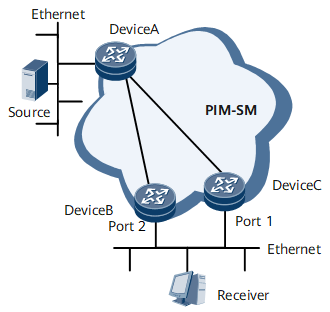BFD for PIM
To minimize the impact of device faults on services and improve network availability, a network device must be able to quickly detect communication faults with adjacent devices. Measures can then be taken to promptly rectify the faults to ensure service continuity.
Hardware detection: For example, the Synchronous Digital Hierarchy (SDH) alarm function can be used to detect link faults. Hardware fault detection mechanisms are fast, but cannot be used in all scenarios by all media.
Slow Hello mechanism: It usually refers to the Hello mechanism of a routing protocol. The detection rate for slow Hello mechanisms is measured in seconds. Detection times of one second or more can result in large losses if data is being transmitted at gigabit rates. For delay-sensitive services, such as voice, a delay of one second or more is also unacceptable.
Other detection mechanisms: Different protocols or manufacturers may provide proprietary detection mechanisms, but it is difficult to deploy proprietary mechanisms when systems are interconnected for interworking.
Bidirectional Forwarding Detection (BFD) is a unified detection mechanism that can detect a fault in milliseconds on a network. BFD is compatible with all types of transmission media and protocols. BFD implements the fault detection function by establishing a BFD session and periodically sending BFD control packets along the path between them. If one system does not receive BFD control packets within a specified period, the system regards it as a fault occurrence on the path.
In multicast scenarios, if the DR on a shared network segment is faulty and the neighbor relationship times out, other PIM neighbors start a new DR election. Consequently, multicast data transmission is interrupted for a few seconds.

Port 2 of Device B is elected as a DR for forwarding multicast data to the receiver. If Port 2 fails, BFD immediately notifies the RM module of the session status and the RM module then notifies the PIM module. The PIM module triggers a new DR election. Port 1 of Device C is then elected as a new DR to forward multicast data to the receiver.
